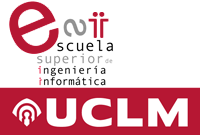Los tutores proporcionarán copias de los proyectos fin de carrera y trabajos fin de grado precedentes a éste (relativos al desarrollo del entorno FLOPER) y realizados por José Manuel Abietar, Pedro José Morcillo, Gustavo Valiente, Carlos Vázquez y MarÃa del Señor MartÃnez.
*** REFERENCIA 1. J. Lloyd, Foundations of Logic Programming, Springer-Verlag, Berlin, 1987, second edition.
*** REFERENCIA 2. R.C.T. Lee. Fuzzy Logic and the Resolution Principle. Journal of the ACM, 19(1):119–129, 1972.
*** REFERENCIA 3. M. Ishizuka, and N. Kanai, Prolog-ELF Incorporating Fuzzy Logic, in Proceedings of the 9th International Joint Conference on Artificial Intelligence (IJCAI'85). Los Angeles, CA, August 1985., edited by A. K. Joshi, Morgan Kaufmann, 1985, pp.701-703.
*** REFERENCIA 4. J. F. Baldwin, T. P. Martin, and B. W. Pilsworth, Fril- Fuzzy and Evidential Reasoning in Artificial Intelligence, John Wiley & Sons, Inc., 1995.
*** REFERENCIA 5. P. Vojtáš and L. PaulÃk. Soundness and completeness of non-classical extended SLD-resolution. In R. Dyckhoff et al, editor, Proc. ELP’96 Leipzig, pages 289–301. LNCS 1050, Springer Verlag, 1996.
*** REFERENCIA 6. J. Medina, M. Ojeda-Aciego, and P. Vojtáš. Similarity-based Unification: a multi-adjoint approach. Fuzzy Sets and Systems, Elsevier, 146:43–62, 2004.
*** REFERENCIA 7. P. Julián, G. Moreno, and J. Penabad. On Fuzzy Unfolding. A Multi-Adjoint Approach. Fuzzy Sets and Systems, Elsevier, 154:16–33, 2005.
*** REFERENCIA 8. G. Moreno. Building a Fuzzy Transformation System. In Proc. of the 32nd Conference on Current Trends in Theory and Practice of Computer Science, SOFSEM'2006. Merin, Czech Republic, January 21-27, edited by J. Wiedermann, G. Tel, J. Pokorný, M. Bieliková, and J. Stuller, Springer LNCS 3831, 2006, pp. 409-418.
*** REFERENCIA 9. J. Abiertar, P. Morcillo, G. Moreno. Designing a Software Tool for Fuzzy Logic Programming. Proceedings of the International Conference on Computational Methods in Science and Engineering 2007 (ICCMSE 2007): Volume 2, parts A and B. 2007.
*** REFERENCIA 10. J. Abietar, P. Morcillo, G. Moreno. Building a Fuzzy Logic Programming Tool. Proc. of VII Jornadas sobre Programación y Lenguajes (PROLE'07), Zaragoza , Spain . September. 12-14. Editor E. Pimentel. Páginas: 215-222, Editorial Thomson-Paraninfo (Madrid). ISBN: 978-84-9732-599-8. 2007.
*** REFERENCIA 11. P. Morcillo, G. Moreno. The Fuzzy Logic Programming Environment FLOPER. 15th International Symposium on formal Methods (FM 2008), "Poster and Research Tools", Turku, Finland. May 26-30. 2008.
*** REFERENCIA 12. P. Morcillo, G. Moreno. Using FLOPER for Running/Debugging Fuzzy Logic Programs. Proc. of the 12th International Conference on Information Processing and management of Uncertainty in Knoledge-based Systems (IPMU'08), Málaga, Spain . June 22-27. Pages 481-488. University of Málaga. (ISBN: 9788461230617). 2008
*** REFERENCIA 13. P. Morcillo, G. Moreno. FLOPER, a Fuzzy Logic Programming Environment for Research. Proc. of VIII Jornadas sobre Programación y Lenguajes (PROLE'08), Gijon, Spain . October 7-10. Pages 259-263, Editorial Fundación Universidad de Oviedo. (ISBN: 978-84-612-5819-2). 2008
*** REFERENCIA 14. P. Morcillo, G. Moreno. Programming with Fuzzy Logic Rules by Using the FLOPER Tool. Proc. of 2nd Intl Symposium on rule Interchange and aplications, (RuleML'08), Orlando, U.S.A. October 30-31. Lecture Notes in Computer Sciences 5321, pp 119-126. Springer-Verlag. 2008
*** REFERENCIA 15. P. Morcillo, G. Moreno, J. Penabad, C. Vázquez. Modeling interpretive steps into the FLOPER environment. Proceedings of the 2010 International Conference on Artificial Intelligence (ICAI 2010) . Edited by: H.R. Arabnia et al., Pages: 16-22. CSREA Press. ISBN 1-60132-148-1. 2010.
*** REFERENCIA 16. P. Morcillo, G. Moreno, J. Penabad, C. Vázquez. A practical management of fuzzy truth-degrees using FLOPER. Edited by: M. Dean, J. Hall, A. Rotolo y S .Tabet. LNCS Lecture Notes in Computer Science ("Semantic Web Rules"). Volume 6403. Pages 119-126. ISSN: 0302-9743, ISBN: 978-3-642-16288-6. Springer-Verlag, Berlin-Heidelberg. 2010
*** REFERENCIA 17. P. Morcillo, G. Moreno, J. Penabad, C. Vázquez. Multi-Adjoint lattices for manipulating truth-degrees into the FLOPER system. PROLE'10, X Jornadas sobre Programación y Lenguajes, Edited by: VÃctor M. GulÃas, Josep Silva y Alicia Villanueva. Pages: 151-161 (sección de trabajos en curso). Edited by: Garceta grupo editorial. ISBN: 978-84-92812-55-4. 2010.
*** REFERENCIA 18. P. Morcillo, G. Moreno, J. Penabad, C. Vázquez. Fuzzy computed answers collecting proof information. Proceedings of the 11th International Work-Conference on Artificial Neural Networks (IWANN’11), special session on “Fuzzy Logic, Soft Computing and Applicationsâ€. Pages: 445-452. Edited by: Springer, LNCS Lecture Notes in Computer Science. 2011.
*** REFERENCIA 19. P. Morcillo, G. Moreno, J. Penabad, C. Vázquez. Declarative Traces Into Fuzzy Computed Answers. Lecture Notes in Computer Science (Proceedings of the 5th International Symposium on Rules (RULEML'11). Edited dy: Springer Verlag, Berlin-Heidelberg (16 pages). 2011.
*** REFERENCIA 20. P.J. Morcillo, G. Moreno, J. Penabad, C. Vázquez (2012). String-based Multi-adjoint Lattices for Tracing Fuzzy Logic Computations. Electronic Communications of the EASST (European Association of Software Science and Technology), Volume: 55, Pages: 1-17. ISSN: 01863-2122. Available: http://journal.ub.tu-berlin.de/eceasst/article/view/820
*** REFERENCIA 21. P.J. Morcillo, G. Moreno, J. Penabad, C. Vázquez (2012). Dedekind-Macneille Completion and Cartesian Product of Multi-Adjoint Lattices. International Journal of Computer Mathematics, 28 May 2012, Pages 1-11. Taylor&Francis (London). ISSN 0020-7160 print/ISSN 1029-0265 online. Available: http://dx.doi.org/10.1080/00207160.2012.689826
*** REFERENCIA 22. G. Moreno, C. Vázquez (2014). Fuzzy Logic Programming in Action with FLOPER. Journal of Software Engineering and Applications, April 2014, Volume 7 (N. 4), Pages 273-298. Scientific Research. ISSN print 1945-3116, ISSN Online: 1945-3124. Available doi: 10.4236/jsea.2014.74028.

